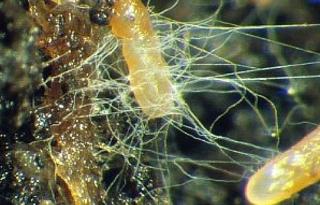A Glimpse into the Life of Trees Below Ground

Walking along tree-lined streets and in township parks, we appreciate trees for the shade their canopies provide, the sounds of leaves in the wind, their contributions to clean air and clean water, and the aesthetics colors of their fall leaves. Likewise, birds, insects, and other wildlife benefit from trees for food and shelter. But only half of the tree is above ground. There exist fascinating community relationships with trees below the surface as well. One example are mycorrhizal fungi. Mycorrhizae is derived from Greek: Mykos means fungus, and Riza means roots.1 These fungi grow on tree roots.
In the process of growing on roots, these fungi form a beneficial relationship with the tree. The fungus absorbs nutrients from the tree and in return the tree receives nitrogen, phosphorus, zinc, manganese and copper, taken up by the fungi from the soil.2 From the tree, the fungi receives sugars created during photosynthesis.
There are many different types of mycorrhizal fungi that benefit woody plants and trees. Some form a dense mat of hyphae (mycelium) surrounding the tree roots; others insert their hyphae into the intercellular spaces of the roots. But the “root” benefit of these fungi are their symbiotic relationships with many species of trees, increasing uptake of nutrients to facilitate growth.
Mycorrhiza fungi are also reported to improve disease resistance, increase drought and salinity stress tolerance, increase transplanting success, and improve soil structure.2
To learn more about Mycorrhizal fungi, some resources are listed at the end of the article.
As we celebrate the trees of the township and all the benefits they provide aboveground, give consideration to all that is going on belowground as well.
Reference:

